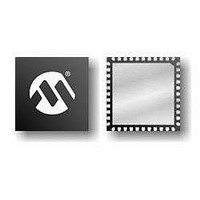PIC16F724-E/MV Microchip Technology, PIC16F724-E/MV Datasheet - Page 119

PIC16F724-E/MV
Manufacturer Part Number
PIC16F724-E/MV
Description
7KB Flash Program, 1.8V-5.5V, 16MHz Internal Oscillator, 8b ADC, CCP, I2C/SPI, A
Manufacturer
Microchip Technology
Series
PIC® XLP™ 16Fr
Datasheet
1.AC164112.pdf
(302 pages)
Specifications of PIC16F724-E/MV
Processor Series
PIC16F
Core
PIC
Program Memory Type
Flash
Program Memory Size
7 KB
Data Ram Size
192 B
Interface Type
I2C, SPI, AUSART
Number Of Timers
3
Operating Supply Voltage
1.8 V to 5.5 V
Maximum Operating Temperature
+ 125 C
Mounting Style
SMD/SMT
Package / Case
UQFN-40
Development Tools By Supplier
MPLAB IDE Software
Minimum Operating Temperature
- 40 C
Core Processor
PIC
Core Size
8-Bit
Speed
20MHz
Connectivity
I²C, SPI, UART/USART
Peripherals
Brown-out Detect/Reset, POR, PWM, WDT
Number Of I /o
36
Eeprom Size
-
Ram Size
192 x 8
Voltage - Supply (vcc/vdd)
1.8 V ~ 5.5 V
Data Converters
A/D 14x8b
Oscillator Type
Internal
Operating Temperature
-40°C ~ 125°C
Lead Free Status / Rohs Status
Details
- Current page: 119 of 302
- Download datasheet (5Mb)
TABLE 12-5:
12.6.3
When Timer1 Gate Toggle mode is enabled, it is pos-
sible to measure the full-cycle length of a Timer1 gate
signal, as opposed to the duration of a single level
pulse.
The Timer1 Gate source is routed through a flip-flop
that changes state on every incrementing edge of the
signal. See Figure 12-4 for timing details.
Timer1 Gate Toggle mode is enabled by setting the
T1GTM bit of the T1GCON register. When the T1GTM
bit is cleared, the flip-flop is cleared and held clear. This
is necessary in order to control which edge is
measured.
© 2009 Microchip Technology Inc.
Note:
WDTE
1
1
0
0
TIMER1 GATE TOGGLE MODE
Enabling Toggle mode at the same time as
changing the gate polarity may result in
indeterminate operation.
WDT/TIMER1 GATE INTERACTION
TMR1GE = 1
T1GSS = 11
and
N
N
Y
Y
WDT Oscillator
Enable
N
Y
Y
Y
PIC16F72X/PIC16LF72X
WDT Reset
12.6.4
When Timer1 Gate Single-Pulse mode is enabled, it is
possible to capture a single pulse gate event. Timer1
Gate Single-Pulse mode is first enabled by setting the
T1GSPM bit in the T1GCON register. Next, the
T1GGO/DONE bit in the T1GCON register must be set.
The Timer1 will be fully enabled on the next
incrementing edge. On the next trailing edge of the
pulse, the T1GGO/DONE bit will automatically be
cleared. No other gate events will be allowed to
increment Timer1 until the T1GGO/DONE bit is once
again set in software.
Clearing the T1GSPM bit of the T1GCON register will
also clear the T1GGO/DONE bit. See Figure 12-5 for
timing details.
Enabling the Toggle mode and the Single-Pulse mode
simultaneously will permit both sections to work
together. This allows the cycle times on the Timer1
Gate source to be measured. See Figure 12-6 for
timing details.
12.6.5
When Timer1 Gate Value Status is utilized, it is possi-
ble to read the most current level of the gate control
value. The value is stored in the T1GVAL bit in the
T1GCON register. The T1GVAL bit is valid even when
the Timer1 Gate is not enabled (TMR1GE bit is
cleared).
12.6.6
When Timer1 Gate Event Interrupt is enabled, it is pos-
sible to generate an interrupt upon the completion of a
gate event. When the falling edge of T1GVAL occurs,
the TMR1GIF flag bit in the PIR1 register will be set. If
the TMR1GIE bit in the PIE1 register is set, then an
interrupt will be recognized.
The TMR1GIF flag bit operates even when the Timer1
Gate is not enabled (TMR1GE bit is cleared).
N
N
Y
Y
TIMER1 GATE SINGLE-PULSE
MODE
TIMER1 GATE VALUE STATUS
TIMER1 GATE EVENT INTERRUPT
Wake-up
N
N
Y
Y
WDT Available for
DS41341E-page 119
T1G Source
N
N
Y
Y
Related parts for PIC16F724-E/MV
Image
Part Number
Description
Manufacturer
Datasheet
Request
R

Part Number:
Description:
IC PIC MCU FLASH 4KX14 44-QFN
Manufacturer:
Microchip Technology
Datasheet:

Part Number:
Description:
IC PIC MCU FLASH 4KX14 44TQFP
Manufacturer:
Microchip Technology
Datasheet:

Part Number:
Description:
IC PIC MCU FLASH 4KX14 40-DIP
Manufacturer:
Microchip Technology
Datasheet:

Part Number:
Description:
7KB Flash Program, 1.8V-5.5V, 16MHz Internal Oscillator, 8b ADC, CCP, I2C/SPI, A
Manufacturer:
Microchip Technology
Datasheet:

Part Number:
Description:
7KB Flash Program, 1.8V-5.5V, 16MHz Internal Oscillator, 8b ADC, CCP, I2C/SPI, A
Manufacturer:
Microchip Technology
Datasheet:

Part Number:
Description:
7KB Flash Program, 1.8V-5.5V, 16MHz Internal Oscillator, 8b ADC, CCP, I2C/SPI, A
Manufacturer:
Microchip Technology
Datasheet:

Part Number:
Description:
7KB Flash Program, 1.8V-5.5V, 16MHz Internal Oscillator, 8b ADC, CCP, I2C/SPI, A
Manufacturer:
Microchip Technology

Part Number:
Description:
IC PIC MCU FLASH 2KX14 28-QFN
Manufacturer:
Microchip Technology
Datasheet:

Part Number:
Description:
IC PIC MCU FLASH 2KX14 28-SOIC
Manufacturer:
Microchip Technology
Datasheet:

Part Number:
Description:
IC PIC MCU FLASH 2KX14 28DIP
Manufacturer:
Microchip Technology
Datasheet:

Part Number:
Description:
IC PIC MCU FLASH 2KX14 28-SOIC
Manufacturer:
Microchip Technology
Datasheet:

Part Number:
Description:
IC PIC MCU FLASH 2KX14 28QFN
Manufacturer:
Microchip Technology

Part Number:
Description:
IC PIC MCU FLASH 2KX14 28SSOP
Manufacturer:
Microchip Technology

Part Number:
Description:
IC PIC MCU FLASH 2KX14 8-SSOP
Manufacturer:
Microchip Technology
Datasheet:

Part Number:
Description:
IC PIC MCU FLASH 2KX14 28-SSOP
Manufacturer:
Microchip Technology
Datasheet:










